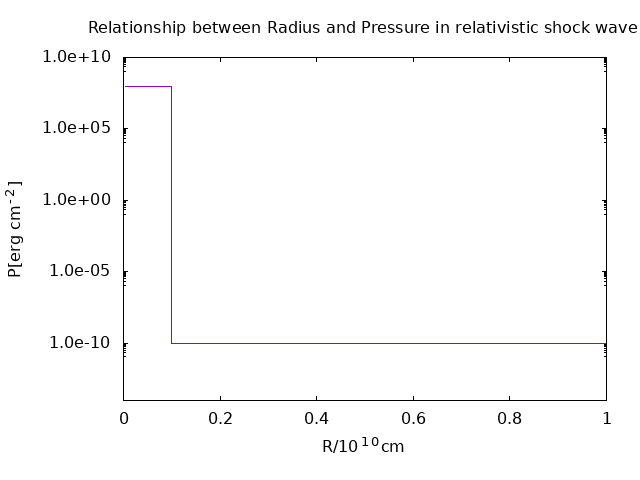top of page
Research & Papers
Introduction
ブラックホールは宇宙に空いた穴ではなく、非常に超高密度な天体です。質量がとても大きい場合、その強い重力によって光の軌道すら変えてしまう現象が起こります。
さらに、ブラックホールは吸い込むだけではなく、落ちてきたものを吹き飛ばしたりエネルギーを解放する性質もあることがわかっています。
未だ謎の多いこの天体に数値シミュレーションを用いて迫ります。


※EHT: Event Horizon Telescope
*My Study
←簡単にブラックホールとシミュレーションの研究について紹介
Papers
Bachelor's thesis

「相対論的衝撃波のシミュレーション」
「Simulation of relativistic shock wave」2019.2
相対論的ジェットと呼ばれるものは中性子星やブラック ホールなどのコンパクトな天体に物質が降着するときに生成される、宇宙で最も高エネルギーで相対論的な現象である。現在 これらのジェットの駆動力について、いまだに解明されていないことが多いが、ジェットが噴出した後のシミュレーションに ついては研究が進んでいる。宇宙ジェットの性質を知るためには、基礎的な相対論的衝撃波について理解を深めることが必須であるので、実際に相対論的衝撃波を流体シミュレーションで再現し、特に球対称衝撃波では自己相似解をもつことを示した。
衝撃波の進む様子
Doctoral dissertation
~ Title ~
Investigating energy and mass flows in supercritical accretion disks
around Kerr-black holes
via general relativistic radiation MHD simulations

Published
TEST run.
Takahashi et al .2016
Fig. 1.
Structure of accretion disks and outflows.
Color shows radiation energy density.
(edge-on, The white circle in the lower left is a black hole.)
降着円盤とアウトフローの形成。
輻射エネルギー密度の2次元図
(円盤上面を横から見ており、左下の白い円がブラックホール)
「Component of energy flow from supercritical accretion disks around rotating stellar mass black holes.」
A. Utsumi(1), K. Ohsuga(1), H. R. Takahashi(2), Y. Asahina(1)
(1)University of Tsukuba (2)Komazawa University
Abstract
By performing two-dimensional axisymmetric general relativistic radiation magnetohydrodynamics simulations with spin parameter a* varying from -0.9 to 0.9, we investigate the dependence on the black hole spin of the energy flow from supercritical accretion disk around stellar mass black hole.
It is found that optically and geometrically thick disks form near the equatorial plane, and a part of the disk matter is launched from the disk surface in all models. The gas ejection is mainly driven by the radiative force,
but magnetic force cannot be neglected, when |a*| is large.
The energy outflow efficiency (total luminosity normalized by Mdot in c^2 ; Mdot in and c are the mass accretion rate at the event horizon and the light speed) is larger for rotating black holes than for non-rotating black holes.
This is 0.7% for a*=-0.7, 0.3% for a*=0, and 5% for a*=0.7 for Mdot in ~ 100 Ledd c^2
(Ledd is Eddington luminosity).
Also, although the energy is mainly released by radiation
when a* ~ 0, the Poynting power increases with |a*| and exceeds the radiative luminosity for models with a* > 0.5 and a* < -0.7.
The more the black hole rotates, the larger the power ratio of the kinetic luminosity to the isotropic luminosity tends to be. This implies that objects with large (small) power ratio may have rapidly (slowly) rotating black holes.
Among ultraluminous X-ray sources, IC342 X-1, is a candidate with a rapidly rotating black hole.
KEYWORDS
-
Black hole
-
Black hole spin
-
Super-critical accretion disks
-
Outflow/Jets
-
"General relativistic radiation magnetohydrodynamics simulations"
Current Study

Preliminary
Fig. 2.
シミュレーションのOver view (a*=0.7)
■2次元図のパネル
(左パネル): BH近傍の輻射エネルギー密度と磁力線(左), プラズマ密度とプラズマ流線(右).
(右パネル): 左パネルを引きで見た図.
■1次元図のパネル
上から"質量降着率", "BH表面の磁束", "magnetic flux parameter", "Luminosity", "エネルギー変換効率".
(黒破線: Total, 赤実線: 輻射成分, 青実線: 磁場成分, 緑実線: 運動エネルギー成分)
「General relativistic radiation-MHD simulations of
magnetically arrested supercritical disk
around Kerr-black hole」
A. Utsumi(1), K. Ohsuga(1), H. R. Takahashi(2), Y. Asahina(1)
(1)University of Tsukuba (2)Komazawa University
~準備中~
KEYWORDS
-
Black hole
-
Black hole spin
-
Super-critical accretion disks
-
Magnetically arrested disk
-
Outflow/Jets
-
"General relativistic radiation magnetohydrodynamics simulations"
bottom of page